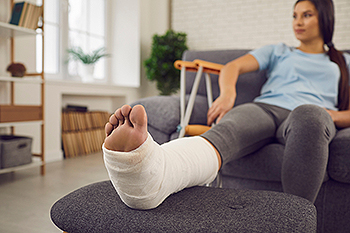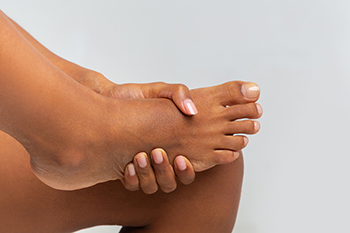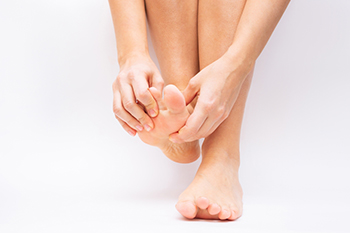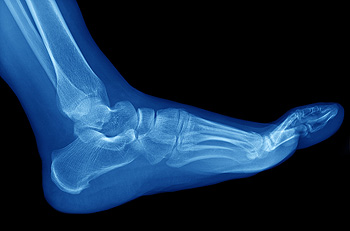Items filtered by date: December 2023
An Overview of a Broken Foot

A broken foot, a disruption in the intricate framework that supports our daily movements, unfolds as a condition with important considerations. This injury, often resulting from trauma, falls, or direct impact, encompasses a spectrum of fractures, ranging from minor cracks in the bones to more severe breaks requiring immediate attention. The metatarsals, the long bones of the foot, and the smaller bones in the toes are susceptible to fractures, each demanding unique diagnostic and treatment approaches. Symptoms of a broken foot include pain, swelling, and difficulty in bearing weight, with potential visible deformities or bruising. Diagnosis typically involves clinical examination and imaging studies to ascertain the nature and extent of the break. Treatment options range from rest and elevation to more intensive interventions like casting or surgery, depending on the severity of the fracture. Understanding this comprehensive overview of a broken foot is pivotal for informed decision-making, ensuring timely and appropriate care for optimal recovery. If you have endured a broken foot, it is suggested that you speak to a chiropodist who can provide the correct treatment for you.
A foot fracture is a crack or break in a foot bone, often caused by repetitive stress on the foot or a high-impact foot injury. If you’re suffering from foot pain, please consult with Chiropodist Stephanie Poupore from North Bay Foot & Ankle. Our clinician can help you maintain the health of your lower limbs and your mobility.
Symptoms
Pain
Bruising
Tenderness
Swelling
Difficulty walking
Deformity
Causes
Repetitive overloading of the foot
Having a previous fracture
Abnormal foot biomechanics
Changing training surfaces suddenly
Poor footwear
Osteoporosis
High-impact injury
Treatments
Rest
Ice
Elevation
Pain medication
Braces or other orthotics
Casts
Crutches
Surgery in more severe cases
If you have any questions, please feel free to contact our office located in . We offer the newest diagnostic and treatment technologies for all your foot care needs.
What Is Erdheim-Chester Disease?

Erdheim-Chester disease is a rare blood cancer characterized by an abnormal increase in histiocytes, which protect the body. This condition leads to widespread inflammation and affects the feet, among other areas of the body. Common symptoms include bone pain in the arms and legs due to increased bone density, and hormonal imbalances causing conditions such as diabetes insipidus. Additionally, brain-related issues such as headaches, seizures, cognitive problems, and sensory and motor difficulties may result from this condition. Complications can involve heart and kidney problems, protruding eyes, night sweats, fatigue, weakness, and weight loss. Symptoms typically appear between ages 40 and 60, but Erdheim-Chester disease can affect people of all ages, with varying severity. Early diagnosis is important, so if you experience these symptoms and your feet are affected, it is suggested that you promptly schedule an appointment with a chiropodist for care.
Foot pain is a common problem treated by chiropodists. If you have foot pain, please consult with Chiropodist Stephanie Poupore from North Bay Foot & Ankle. Our clinician can help you maintain the health of your lower limbs and your mobility.
When you are experiencing foot pain, it’s important to note the type of pain and its location, as this can help determine a diagnosis.
Pain in the top of the foot may be caused by:
Stress fractures
Sinus tarsi syndrome
Extensor tendonitis
Tibialis anterior tendonitis
Gout
Athlete’s foot
Ganglion cysts
Pain in the bottom of the foot may be caused by:
Plantar fasciitis
Foot cramps
Tarsal tunnel syndrome
Plantar fibromatosis
Posterior tibial tendonitis
Stress fractures
Flat feet
Pain on the side of the foot may be caused by:
Ankle sprain
Cuboid syndrome
Peroneal tendonitis
Stress fractures
Bunions
Corns or calluses
Posterior tibial tendonitis
Heel pain may be caused by:
Plantar fasciitis
Achilles tendonitis
Bone spurs
Heel fractures
Retrocalcaneal bursitis
Sever’s disease
Pain in the toes may be caused by:
Gout
Hammertoe
Turf toe
Bunions
Ingrown toenails
Blisters
Arthritis
These and many more conditions can be treated by a chiropodist. If you have any questions, please feel free to contact our office located in . We offer the newest diagnostic and treatment technologies for all your foot care needs.
It's Time for Beautiful Feet
Symptoms of Arthritis in Toe Joints

Arthritis, a pervasive condition affecting joints, can extend its reach to the toes, presenting distinctive symptoms that warrant attention. One prevalent indicator is pain, often described as aching or throbbing, which may intensify with movement or weight-bearing activities. Swelling and stiffness in the toe joints are common manifestations, limiting flexibility and mobility. As arthritis progresses, the affected toes may exhibit deformities, such as a claw-like appearance, as joint erosion alters their natural alignment. Reduced range of motion in the toes, accompanied by a sensation of warmth or tenderness, further underscores the potential presence of arthritis. In some cases, individuals may experience joint instability, making activities like walking or standing challenging. Identifying these nuanced symptoms is important for timely intervention and appropriate management strategies. If you have toe pain, it is strongly suggested that you are under the care of a chiropodist who can accurately diagnose toe arthritis, and offer correct treatment strategies.
Toe pain is common and can have a variety of causes. Causes can range from a broken toe to an ingrown toenail. Many types of toe pain can be corrected, but any toe pain that inhibits your activities for an extended period should be discussed with a chiropodist. If you suffer from toe pain, please consult with Chiropodist Stephanie Poupore from North Bay Foot & Ankle. Our clinician can help you maintain the health of your feet.
Common Causes of Toe Pain
- Trauma or fracture
- Cuts, sores, or bruises
- Rheumatoid arthritis
- Gout
- Turf Toe
- Morton’s neuroma
- Blisters
- Corns
- Bunions
- Hammertoes
- Ingrown toenails
- Plantar warts
- Athlete’s Foot
Symptoms of Toe Pain
- Toe deformity
- Burning
- Numbness
- Toenail deformity
- Wart or ulcer
- Swelling
- Redness
When to See a Chiropodist
- Bleeding or severe swelling
- Trauma, such as a broken bone
- Discoloration or extreme swelling
- Inability to bear weight
- Persistent pain
- Wounds that won’t heal
Diagnosis of Toe Pain
A chiropodist can conduct a thorough examination of the painful toe or toes in order to determine the best course of treatment. The exam may include assessing the tenderness of the area, taking an X-ray or other diagnostic test, or assessing your gait and range of motion. A discussion of what led to the advanced pain issue may follow. Included will likely be a health history, as well as a list of medications you are taking and other previous injuries you may have sustained.
Treatment for Toe Pain
With such a wide range of possible causes for toe pain, treatment can be varied in scope and length. Sometimes, the chiropodist will recommend lifestyle and activity changes. In cases of trauma or other injuries, X-rays or imaging tests will likely be used to determine the severity of the problem, particularly if any bones have been broken. Treatment may also include injections of pain-relief medication or anti-inflammatory drugs. Certain injuries will require the splinting, bracing, or wrapping of injured toes. Orthotics or special shoes may be prescribed in cases of bone deformities and gait issues. Removal of warts, calluses, and corns may be needed. In other cases, such as with patients who have diabetes or rheumatoid arthritis, ongoing treatment may be required to avoid more serious problems.
Understanding the Musculoskeletal Marvels of the Feet

The musculoskeletal system of the feet is a marvel of intricate design, serving as the foundation for our mobility and daily activities. Comprised of bones, joints, muscles, tendons, and ligaments, this complex network functions seamlessly to support the body's weight, maintain balance, and facilitate movement. The arches, longitudinal and transverse, provide structural integrity and distribute forces evenly, absorbing the impact of each step. Muscles and tendons work in harmony, orchestrating the precise movements of the toes, ankles, and the entire foot. Joints, such as the ankle and subtalar joints, allow for a wide range of motion while ensuring stability. Ligaments act as strong yet flexible connectors, securing the bones and preventing excessive movement. Understanding the intricacies of the musculoskeletal system in the feet is essential for appreciating the role it plays in our daily lives and recognizing the importance of proper foot care to maintain optimal function and mobility. If you would like additional information about the biomechanics of the feet, it is suggested that you visit a chiropodist who can provide you with interesting knowledge.
The biomechanics of your feet play an important role in your foot health. To learn more, please consult with Chiropodist Stephanie Poupore from North Bay Foot & Ankle. Our clinician can help you maintain the health of your lower limbs and your mobility.
Foot biomechanics refers to the study of the structure, function, and motion of the feet. The feet and ankles are a complex system consisting of many bones, joints, ligaments, muscles, and tendons that work together to move your feet. Understanding the unique biomechanics of your own feet can help you and your chiropodist make informed decisions about your foot health care. This includes decisions about the best preventive measures to avoid foot pain, the best treatment options for various foot problems, and finding the best shoes for your feet.
If you have any questions, please feel free to contact our office located in . We offer the newest diagnostic and treatment technologies for all your foot care needs.

